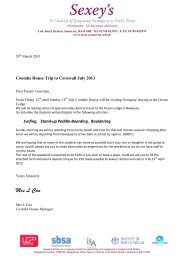Untitled - Sexey's School Moodle
Untitled - Sexey's School Moodle
Untitled - Sexey's School Moodle
You also want an ePaper? Increase the reach of your titles
YUMPU automatically turns print PDFs into web optimized ePapers that Google loves.
elements—and its Preface, where the author justifies his use of what was perceived as<br />
“low” and contemptible devices. Of “Hart-Leap Well” for example, Gamer observes that<br />
“in many ways, the poem is almost duplicitous in the way it allows both Wordsworth and<br />
his readers first to indulge in the supernatural speculation of low and rustic characters and<br />
then to ally themselves with a more philosophical and chastened interpretation of the<br />
same events” (14). To some extent, this calls in the same notions of distinction between<br />
terror and horror that was pointed out earlier in the comparison between Lewis and<br />
Radcliffe; whereas, in the case of the Lyrical Ballads the “supernatural” is used to<br />
produce the same type of “intellectual speculation” that Radcliffe assumed terror to<br />
produce.<br />
135<br />
On a different level, critical theories such as psychoanalysis, reader-response, and<br />
feminism have considerably influenced the ways in which Gothic texts are approached.<br />
Perhaps most notably, psychoanalysis has provided the most insightful ways of reading<br />
the Gothic to unleash its discursive possibilities. For example, by using the theories of<br />
psychoanalysis, the reader can unveil certain patterns of social, political, and cultural<br />
repression as they may situate themselves in the narrator and/or his/her characters. On<br />
the other hand, one cannot stress enough the considerable contributions of Freud’s theory<br />
of the “Uncanny,” which examines the properties of a text that provoke a feeling of<br />
unfamiliarity and uneasiness, which is possibly disturbing, unsettling, and uncomfortable,<br />
as it successively reveals certain patterns of repression and exerts directive power of the<br />
reader by strongly affecting his/her response. In The Monk, the uncanny manifests itself<br />
on various levels: in the disclosure of horrific evens, such as the description of putrefied<br />
bodies and sanguinary beatings cited above; second, in the premise that the supernatural



